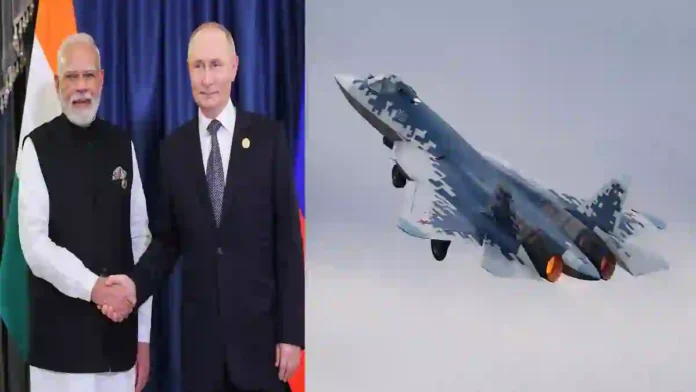Russia to study Su-57 fighter jet production in India, a possible game-changer for India’s air force modernisation
In a significant development for India’s defence modernisation plans, Russia is currently conducting comprehensive studies to assess the scale of investment required to establish production of its fifth-generation Su-57 fighter jets within India.
Read- Rajnath Singh Announces Progress On Indigenous Powerful Jet Engine
This initiative comes at a time when New Delhi has expressed a growing requirement for advanced fifth-generation combat aircraft, with an initial demand estimated at two to three squadrons.
The Indian Air Force is evaluating both the Russian Su-57 and the American F-35 as potential options to meet this critical capability gap.
India already has substantial experience in licensed production of Russian-origin aircraft through Hindustan Aeronautics Limited (HAL), which domestically manufactures the Su-30MKI fighter jets at its Nashik facility.
Defence sources reveal that this industrial capacity could potentially be leveraged to accommodate the production of Su-57 fighters, thus minimising setup costs and streamlining the transfer of technology.
In addition, India has other manufacturing facilities engaged in producing Russian-origin defence systems—these too may be integrated into the broader ecosystem required for assembling Su-57 jets locally, thereby improving cost-effectiveness and supporting the “Make in India” vision for defence manufacturing.
The strategic context of these talks is particularly significant. India and Russia have been strengthening defence relations at a time when ties between India and the United States have faced strains due to Washington’s frequent criticism of New Delhi and the imposition of trade tariffs.
Read- Modi says Russia and India stand together even in difficult times
In this backdrop, Russia has been actively pushing India to acquire the Su-57, with senior Russian leadership emphasising the strategic and technological advantages of the platform.
India, notably, was earlier a participant in Russia’s Fifth Generation Fighter Aircraft (FGFA) program—a derivative of the Su-57 project—but withdrew nearly a decade ago due to concerns over cost, timelines, and technology-sharing mechanisms. Current circumstances, however, suggest that a revival of this collaboration cannot be ruled out, especially in the context of evolving geopolitical and security dynamics.
Beyond fighter jets, India and Russia have also been engaged in discussions on advanced air defence systems such as the S-400 (already procured by India) and the cutting-edge S-500, along with other high-value defence technologies.
This multifaceted cooperation underscores the deepening of defence-industrial relations between the two nations. At the same time, the United States has been lobbying New Delhi to consider the F-35, further intensifying the competition for India’s fifth-generation fighter acquisition program.
Parallel to these external offers, India has embarked on its indigenous fifth-generation fighter initiative, known as the Advanced Medium Combat Aircraft (AMCA) project.
Read- Army Begins Raising New ‘Bhairav’ Commando Units For Swift Strikes On China, Pakistan Fronts
Approved by the Indian government last year, the AMCA program envisages the development of a stealth-capable fighter aircraft with its maiden test flight projected for 2028 and potential induction by 2035.
While the AMCA effort reflects India’s long-term push for self-reliance in defence technology, experts acknowledge that foreign platforms like the Su-57 or F-35 may still be necessary in the interim to address urgent capability requirements of the Indian Air Force.
The evaluation of investment requirements for local production of the Su-57 highlights Russia’s keen interest in re-establishing a strategic fighter aircraft partnership with India.
The eventual decision by New Delhi will likely hinge on a careful assessment of cost, technology transfer, industrial participation, and the balance of geopolitical equations with Moscow and Washington.
The coming months, therefore, could prove decisive in shaping the trajectory of India’s future combat aviation fleet and its broader defence-industrial strategy.
Based On ANI Report




